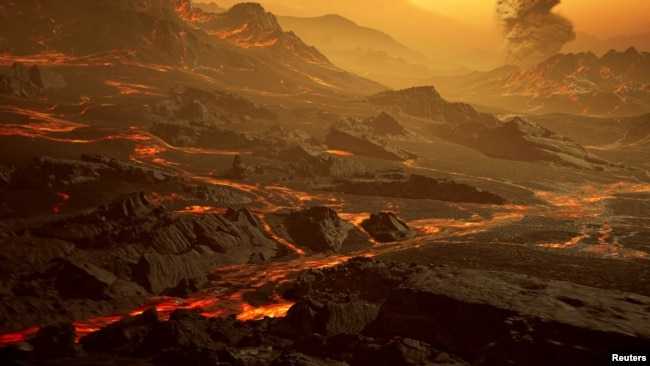宇宙に思いを馳せる。。。
夜、空を見上げのは心を開放することができます。
今の悩みや、迷いを一瞬忘れさせてくれたり、小さなことのように思えて、違った心の持ち方を与えてくれたりします。
科学者の目は、もっと壮大なことに注がれているのですね。飽くなき探究心。
早速今日のVOA、
思いを宇宙に、惑星外惑星に、、26.3光年の彼方へ⭐️
- 遠くの惑星の大気を知る手がかりになるかもしれない大型惑星
- Large Planet May Offer Clues about Atmospheres on Distant Worlds
- It is useful to know grammar. 文法を知ることは有益です。
- I found it useful to be able to know it. それを理解することは有益だとわかった。
- また、useful to+人 ~にとって役立つ
- This book is useful to me. この本は私には役立ちます。
遠くの惑星の大気を知る手がかりになるかもしれない大型惑星
Large Planet May Offer Clues about Atmospheres on Distant Worlds
58 minutes ago/2021/14/Jan.
科学者たちは、岩石の多い地球に似た惑星を発見しました。この惑星は、他の大気を研究するチャンスになるかもしれません。このような研究は、地球外の生命体の探索に役立つ可能性があります。
研究者たちは最近、グリーゼ486bと呼ばれるこの惑星は、生命が存在する可能性自体は高くないと述べています。太陽系に比較的近い恒星の軌道上にあるグリーゼ486 bは、金星のように高温で乾燥しており、表面には溶岩の川が流れている可能性があります。
しかし、地球に近いことやその物理的性質から、大気の研究に適していると考えられます。このような研究には、アメリカの宇宙機関であるNASAが10月に打ち上げを予定しているジェームズ・ウェッブ宇宙望遠鏡をはじめとする、次世代の望遠鏡が使用されます。
これらの望遠鏡は、生命体が存在する可能性のある惑星を含む、その他の太陽系外惑星の大気を研究するためのデータを提供してくれるでしょう。
exoplanets:太陽系外惑星 【éksəuplæ̀nit】
スペインのCentro de Astrobiología(宇宙生物学センター)のJosé Caballero(ホセ・カバレロ)は、雑誌 Science に掲載された研究の共同執筆者です。
カバレロ氏は、この新しい研究の可能性を "太陽系外惑星学のロゼッタストーン "と呼んでいます。これは、古代エジプトの文字を理解するのに役立った古代の石に例えているのです。
科学者たちは、これまでに4,300個以上の太陽系外惑星を発見しています。その中には木星のような大きなガス惑星もあります。
そのほかには、岩石質の地球のような小さな惑星もあります。これらの惑星は、生命が存在する可能性があると考えられています。しかし、現在の科学機器では、これらの惑星の大気についてはほとんど分かっていません。
ドイツのマックス・プランク天文研究所のトリフォン・トリフォノフ氏は、今回の研究の筆頭著者です。トリフォノフ氏は、大気の研究に適した太陽系外惑星には、特定の性質が必要だと述べています。
グリーゼ486bは、地球から約26.3光年−光が1年で進む距離−、約9.5兆kmの距離にあります。最も近い太陽系外惑星の一つです。太陽よりも小さく、温度が低く、明るさも低い恒星の周りを回っています。グリーゼ486bの質量は、地球の2.8倍。
この惑星はその母星のすぐ近くを回っています。表面温度は約430℃で、表面重力は地球の70%程度と考えられています。
トライフォノフ氏は、「グリーゼ486bは、少なくとも地球上で私たちが知っているような居住可能な惑星ではありません」と語っています。
しかし、グリーゼ486bは、ジェームズ・ウェッブ宇宙望遠鏡や、現在チリで建設中の超大型望遠鏡を使って、地球型惑星の大気を研究するのに役立つ可能性があります。
大気中の化学物質の混合状態は、惑星とその惑星が生命を育む能力について多くのことを教えてくれます。
カベロ氏は、グリーゼ486bや他の地球型惑星から得られる知見は、生命体が存在する可能性のある他の太陽系外惑星の大気をより深く理解するのに役立つだろうと述べています。
Large Planet May Offer Clues about Atmospheres on Distant Worlds
The surface of the newly discovered exoplanet called Gliese 486 b, a type of planet known as a "hot super-Earth" is seen in an undated artist's impression. (Renderarea/Handout via REUTERS )
Scientists have found a rocky, Earth-like planet that may offer a chance to study other atmospheres. This kind of research could help the hunt for life outside of Earth.
The researchers said recently that the planet, called Gliese 486 b, is not itself likely to have life. Orbiting a star relatively near our solar system, Gliese 486 b is hot and dry like Venus, with possible rivers of lava flowing on its surface.
But its nearness to Earth and its physical qualities make it well- suited for a study of its atmosphere. Such research will use the next generation of telescopes, including the James Webb Space Telescope that the American space agency NASA plans to launch in October.
These telescopes could give scientists data to study the atmospheres of other exoplanets - planets beyond our solar system - including ones that may have life.
José Caballero of the Centro de Astrobiología in Spain was the co-writer of the research that appeared in the journal Science.
Caballero called the new research possible, “the Rosetta Stone of exoplanetology.” He was comparing it to the ancient piece of stone that helped experts understand ancient Egyptian writing.
Scientists have discovered more than 4,300 exoplanets. Some have been large gas planets similar to Jupiter.
Others have been smaller, rocky Earth-like worlds. These are considered candidates for having life. But current scientific instruments tell us little about their atmospheres.
Trifon Trifonov of the Max Planck Institute for Astronomy in Germany was the lead writer of the research. Trifonov said an exoplanet needs to have certain qualities to work well for atmospheric study.
Gliese 486 b is located about 26.3 light-years - the distance light travels in a year - from Earth, or about 9.5 trillion kilometers. It is among the closest exoplanets. It orbits a star that is smaller, cooler, and less bright than our sun. Gliese 486 b’s mass is 2.8 times greater than Earth’s.
The planet orbits very close to its home star. Its surface temperature is about 430 degrees Celsius and its surface gravity maybe 70 percent stronger than Earth’s.
“Gliese 486 b cannot be habitable, at least not the way we know it here on Earth,” Trifonov said.
Still, Gliese 486 b could prove useful for studying the atmosphere of an Earth-like planet using the James Webb Space Telescope and the future Extremely Large Telescope, which is now being built in Chile.
The chemical mixture of an atmosphere can tell a lot about a planet and its ability to have life.
Cabellero said that what we learn from Gliese 486 b and other Earth-like planets could help scientists better understand the atmospheres of other exoplanets that may have life.
Words in This Story
lava – n. melted rock from a volcano
journal -- n. a magazine that reports on things of special interest to a particular group of people
habitable – adj. suitable or fit to live in
英語の小窓ー語法とコロケーション useful
本文中にあった
prove useful for:~に有用であるのが分かる
から "useful " をとりあげます。
useful 【形】 役立つ、便利な 有益な、価値ある という意味ですね。
例文:This book is useful for writing her report.
useful to writeのようにto不定詞を持って来れません。usefulの語法上、to不定詞を持ってくることはできないからです。
ですが、仮主語のitが使われたり、I find(~とわかる)というような場合はto不定詞が多く使われます。
It is useful to know grammar. 文法を知ることは有益です。
I found it useful to be able to know it. それを理解することは有益だとわかった。
また、useful to+人 ~にとって役立つ
This book is useful to me. この本は私には役立ちます。
This book will be useful to you in learning English. あなたが英語を学習するのにこの本は役立つでしょう。
